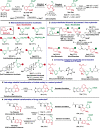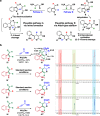Nature-inspired remodeling of (aza)indoles to meta-aminoaryl nicotinates for late-stage conjugation of vitamin B3 to (hetero)arylamines
- PMID: 33298909
- PMCID: PMC7726565
- DOI: 10.1038/s41467-020-19610-2
Nature-inspired remodeling of (aza)indoles to meta-aminoaryl nicotinates for late-stage conjugation of vitamin B3 to (hetero)arylamines
Abstract
Despite the availability of numerous routes to substituted nicotinates based on the Bohlmann-Rahtz pyridine synthesis, the existing methods have several limitations, such as the inevitable ortho-substitutions and the inability to conjugate vitamin B3 to other pharmaceutical agents. Inspired by the biosynthesis of nicotinic acid (a form of vitamin B3) from tryptophan, we herein report the development of a strategy for the synthesis of meta-aminoaryl nicotinates from 3-formyl(aza)indoles. Our strategy is mechanistically different from the reported routes and involves the transformation of (aza)indole scaffolds into substituted meta-aminobiaryl scaffolds via Aldol-type addition and intramolecular cyclization followed by C-N bond cleavage and re-aromatization. Unlike previous synthetic routes, this biomimetic method utilizes propiolates as enamine precursors and thus allows access to ortho-unsubstituted nicotinates. In addition, the synthetic feasibility toward the halo-/boronic ester-substituted aminobiaryls clearly differentiates the present strategy from other cross-coupling strategies. Most importantly, our method enables the late-stage conjugation of bioactive (hetero)arylamines with nicotinates and nicotinamides and allows access to the previously unexplored chemical space for biomedical research.
Conflict of interest statement
The authors declare no competing interests.
Figures





Similar articles
-
A cascade reaction of azolopyrimidines. Synthesis of unusual indole and azaindole derivatives.Chem Commun (Camb). 2012 Sep 21;48(73):9171-3. doi: 10.1039/c2cc34539k. Epub 2012 Aug 8. Chem Commun (Camb). 2012. PMID: 22872298
-
A Tetrazine-Based Synthesis for Accessing Underutilized Aza-Indole Analogues.Chemistry. 2025 May;31(25):e202500751. doi: 10.1002/chem.202500751. Epub 2025 Apr 15. Chemistry. 2025. PMID: 40035507 Free PMC article.
-
Uncatalyzed one-pot synthesis of highly substituted pyridazines and pyrazoline-spirooxindoles via domino SN/condensation/aza-ene addition cyclization reaction sequence.ACS Comb Sci. 2013 Jun 10;15(6):278-86. doi: 10.1021/co400005y. Epub 2013 Apr 26. ACS Comb Sci. 2013. PMID: 23621648
-
Biomimetic Approaches Towards The Synthesis of Complex Dimeric Natural Products.Curr Pharm Des. 2016;22(12):1628-57. doi: 10.2174/1381612822666160101123106. Curr Pharm Des. 2016. PMID: 26721256 Review.
-
Facile and Green Synthesis of Saturated Cyclic Amines.Molecules. 2017 Oct 12;22(10):1691. doi: 10.3390/molecules22101691. Molecules. 2017. PMID: 29023406 Free PMC article. Review.
Cited by
-
Synthesis and crystal structure of 5-{(E)-[(1H-indol-3-ylformamido)-imino]-meth-yl}-2-meth-oxy-phenyl propane-1-sulfonate.Acta Crystallogr E Crystallogr Commun. 2025 Mar 11;81(Pt 4):310-313. doi: 10.1107/S2056989025002087. eCollection 2025 Apr 1. Acta Crystallogr E Crystallogr Commun. 2025. PMID: 40201003 Free PMC article.
-
A computer-aided method for controlling chemical resistance of drugs using RRKM theory in the liquid phase.Sci Rep. 2021 Nov 26;11(1):22971. doi: 10.1038/s41598-021-01751-z. Sci Rep. 2021. PMID: 34836999 Free PMC article.
-
Synthesis of substituted pyridines with diverse functional groups via the remodeling of (Aza)indole/Benzofuran skeletons.Commun Chem. 2023 Jun 7;6(1):112. doi: 10.1038/s42004-023-00914-5. Commun Chem. 2023. PMID: 37286709 Free PMC article.
-
Unveiled reactivity of masked diformylmethane with enamines forming resonance-assisted hydrogen bonding leads to di-meta-substituted pyridines.Commun Chem. 2024 Jun 28;7(1):146. doi: 10.1038/s42004-024-01228-w. Commun Chem. 2024. PMID: 38942965 Free PMC article.
References
Publication types
MeSH terms
Substances
LinkOut - more resources
Full Text Sources
Other Literature Sources

